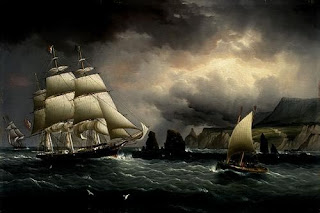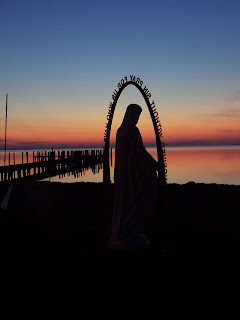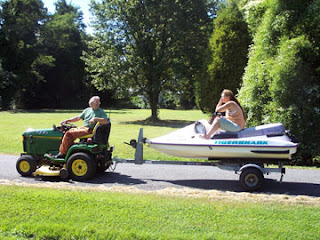
Why did two ships of colonists risk a dangerous crossing of the Atlantic Ocean in 1633 to flee England for America and why did they bring their hopes for religious freedom to St. Clement's Island Maryland? To understand the history of St. Clements one needs to understand there is another part of the story, the history of events in the 16th Century which a few years later would cause the colonists to leave England for America.
Let's call it the European pre-history of St. Clements and quite frankly you might be a bit surprised by what you learn. This prehistory includes a series of international events involving the most powerful monarchies, legendary family dynasties, and mighty empires in Europe beginning with the infamous King Henry VIII of England.
St. Clements Island was the site of the first declaration of religious freedom to be guaranteed anywhere in the world, a freedom that in time would become embedded in our US Constitution. A little over 100 years earlier Henry VIII set in motion the series of events that would result in this charter.
Events in Europe during the 16th century led to the fall from favor of the Catholics and Puritans in England and the subsequent journey to settle the colony of Mary Land in 1634 where religious freedom would be guaranteed. Monarchies in England, Scotland, France, Spain and Italy and the Vatican in Rome were all to play a role in this decision to settle in the new world.
A web of intrigue led to a mosaic of treachery, murder, assassination, torture, arranged marriages and more in the alliances and enemies that came and went beginning with the reign of Henry VIII in England who was born in 1491, the year before Columbus discovered America, and was King from 1509 to 1547. Here are more of the people who made the landing at St. Clements possible.

Captain John Smith - 1st Governor of Jamestown
A leader of the first English attempt to colonize the new world at Jamestown, Captain John Smith was such a colorful character that when the boats arrived in America the officials in charge of the settlement wanted to prosecute Smith for mutiny because of his actions on the way to America. But when they opened the official charter for Jamestown the sponsors had designated that Smith would be one of the leaders and the first governor.
Smith was best known for being saved by the Indian Princess Pocahontas when her father the Chief was going to put him to death. A couple of years later Pocahontas again saved Smith from being killed in an ambush. But contrary to efforts by Walt Disney to change history, Pocahontas and Smith had no romantic involvement.
In 1609 Smith was injured during the Indian wars and returned to England for treatment. He never made it back to Jamestown but did explore New England in 1614 and 1615. During the latter expedition he was captured by French pirates but escaped several weeks later and made his way to England. It was the last time he was in the New World though his books on America inspired many English to become part of the colonization of America.

Pocahontas - Indian Princess
I mentioned that Pocahontas twice saved John Smith who later advised Calvert to secure the Mary Land territory. Though she had no romantic involvement with Smith like the Disney movie, she did marry an English settler who lost his wife soon after he arrived. John Rolfe fell in love with Pocahontas when she was being held captive by settlers afraid of an Indian uprising. They married and he took her to England to meet King James, with the help of John Smith.
As they were preparing to leave England and return home she came down with a disease and died at the age of 22. When he returned to America Rolfe went on to develop the tobacco crop that was more valuable than gold in trade with Europe. Because Mary Land was much better suited for raising tobacco it became the primary source of the valuable commodity for Europe.

Cecilius Calvert, 2nd Baron Baltimore
If a father has to trust a son to finish his work there could be no better son than Cecil who spent the rest of his life after his father's death making sure the colony of Mary Land lived up to the dreams of his father. Just five weeks after his father died the long awaited charter came through but not until it had survived challenges from the Virginia colonists and from the Protestants in Parliament.
Since his father had already planned the mission and his two boats from the Newfoundland adventure were available, the Ark and the Dove, Cecil, the new Lord Baltimore set about finishing the work. Father White and others had been hard at work securing the gentlemen whose investment was crucial to make the journey. A total of 17 eventually invested in the effort and over 300 people sailed on the ships.
Well aware of the efforts in Parliament to strip the Calverts from their land in America because they claimed the right of religious freedom, Cecil decided to remain in England and defend against their enemies and it was a good thing he did. He sent two younger brothers, Leonard and George with the boats along with Father White while the passengers were about evenly split between the Catholics and Protestants.
The landing in March of 1634 was the culmination of his father's dream while the establishment of Mary Land as a palatinate gave Lord Baltimore and his descendants rights nearly equal to an independent state including the right to wage war, collect taxes and establish a colonial nobility. Such rights had never been granted before.
Sir George and Cecil Calvert were extraordinary visionaries dedicated to provide a safe haven where all religions could be practiced. The Calvert's ability to overcome the opposition from the Church of England and parliament and maintain the cooperation of the Protestant King while developing a colony with religious freedom was a major step toward the guarantee of religious freedom in the US Constitution some 153 years later.

Leonard Calvert - 1st Governor of Mary Land
Brother of Cecil Calvert, Leonard had accompanied his father Sir George on a voyage to Newfoundland so he was experienced in the demands of colonization and the need for food, safety and cooperation with the Native Americans. When Cecil had the expedition to Mary Land organized, with the help of Father Andrew White, it was his brother Leonard that Cecil chose to be the first governor of the new colony.
Upon arriving in Mary Land at St. Clements Island Leonard read the charter that had been prepared by Sir George Calvert and Father White guaranteeing religious freedom in Mary Land. Somehow his father and brother had negotiated a grant with the king that gave the colony nearly the same status as an independent state thus the Charter they drafted was the first one to guarantee religious freedom anywhere in the world. It was to be a major influence for freedom of religion in our Constitution.
Leonard had a fort built on St. Clements Island and went to meet the Emperor of the Algonquin tribes in Mary Land to assure them the settlers came in peace and to get their approval to develop a colony in Mary Land. No other European settlements did this and it is why the others were plagued with hostilities from the Native Americans while Mary Land was the only place where peace existed from the first day. About a month later he moved the colonists to the site of St. Mary's City.
The planning and management of the colony by the Calverts was exceptional as the first summer they were already shipping corn and fish to New England settlements. The history of colonial America does not do justice to the role played in settling the colonies by the Calverts or Father White nor to the model of Mary Land as the most successful colony in America. From 1634 to 1776 there were 37 governors in Maryland, of which 23 were appointed by Lord Baltimore, the Calvert family. Calvert family members served 8 of the 23 terms.

Father Andrew White - 1st Jesuit In English Speaking Colonies
Born in London, White entered a Spanish seminary, studied in Douai, France, and was ordained a priest in 1605. He risked a cruel death during a period of renewed Catholic persecution by becoming a missionary to Protestant England. In 1606, he was captured and banished from England following the Gunpowder Plot, an attempt by radical Catholics to kill the new King of England, James I and the entire English parliament. It was discovered just before the explosion was to take place.
The conspirators were put to death and many other priests were banished from England because of their Catholic sympathies. Father While was sent to Europe and joined the Society of Jesus the next year. Beginning in 1628 he began helping Sir George Calvert and later Cecil Calvert plan for the colonization of America.
He is principally known to American history for his writings and labors in connection with colonizing Maryland which earned him the title of "Apostle of Maryland". Sir George Calvert, first Lord of Baltimore, corresponded with him from Avalon in Newfoundland; Father Vitelleschi, General of the Jesuits, makes mention of him for the first time regarding a mission to English America in a letter dated Rome, 3 March, 1629.
In preparation for the founding of the Maryland Colony he composed the "Declaratio Coloniae Domini Baronis de Baltimore", to attract settlers and co-operators in the enterprise. The expedition set sail on 22 Nov., 1633, from Cowes, Isle of Wight. He is the author of the "Relatio itineris", which constitutes the classical authority in regard to colonizing early Maryland. His writings are the best surviving testimony to the colonization of America while his translations of various documents into the Native American language were the first in the new world.
The Ark and the Dove landed in early March and after several weeks were spent building the fort and meeting with Indian leaders on the Feast of the Annunciation, 25 March, 1634, the "Pilgrims" of Maryland held a formal ceremony on St. Clement's Island, where Mass was celebrated for the first time in English speaking America. "Maryland Day" on March 25 has been declared in remembrance of the amazing achievements of the St. Clements colonists.

When they arrived Father White was given a cabin by the Indians on a creek just north of St. Clements where he could meet with them and teach them about the Catholic religion. It was the 1st Catholic chapel in English speaking America and hundreds and maybe thousands of Native Americans were converted by Father White and the Jesuits. For ten years Father White devoted himself with apostolic humility, patience, and zeal to missionary labours amongst the settlers and the Native Americans.
The "Annual Letters" narrate his successful labors amongst the tribes of the Patuxent and Potomac; he carried the Gospel to the Anacostans in the neighborhood of our current nation's capital; he converted and baptized with solemn ceremonies on 5 July, 1640, with Governor Calvert and other civil dignitaries being present, Chitomachon, the Tayac or "Emperor of Piscataway". He composed a grammar, dictionary, and catechism in the native idiom, being the first Englishman to reduce an Indian language to grammatical form.
The Puritan party in England began to openly challenge the efforts by Queen Henrietta to rally the Catholics to help King Charles and the growing tension was felt with disastrous effects on Catholic interests in Maryland where a band of protestant marauders from Virginia plundered the Jesuit establishments in Mary Land. Three Jesuit priests in the Inigoes settlement were chased across the river to Virginia then hunted down and murdered becoming the first martyrs in Colonial America.
The invaders seized Father White with two companions and sent him in irons to London in 1645. After two years in prison he was finally tried on the charge of treason of being a Catholic priest in England which violated English law. Conviction would result in being put to death.
White was acquitted on the manifest pleas that he had entered the country (England) under force and much against his will but he still had been held at Newgate prison until January of 1648 before he was released and then never allowed to return to America again. Newgate was a 700 year old prison in London notorious for inhumane conditions, disease, torture and being a holding prison for those sentenced to death. Though he longed to return to his dear Marilandians" his earnest petitions would not be granted and he died in England in 1656.
During the journey to America twice the ships were caught in devastating storms and no one thought they would survive. Father White used a sacred relic, a piece of the True Cross of Jesus he brought with him to pray for help and credited it with saving the ships from the hurricanes. Again he used the piece of the True Cross to heal the son of the Native American Emperor who seemed to be dying. As a result the Emperor and his family converted to Catholicism.
His work to establish the Jesuits in America resulted in Father White being declared the founder of the Jesuits in America and forefather of Georgetown University, the most famous Jesuit university. Other firsts included erecting the first Catholic Cross on St. Clements Island, holding the first Roman Catholic Mass in English speaking colonies and establishing the first Catholic chapels and churches in the original colonies. Like the Calverts, Father White is largely ignored in history books and his contributions to religious freedom as well as the contributions of many others pointed out deserve a much more prominent place in American colonial history.

Dr. Thomas Gerard - Owner of St. Clements Manor
Gerard was from a prominent family in England whose direct descendants were Prince Charles and Lady Diana of the royal family. He was a Catholic and came from a noble lineage of Catholics who were activists against the Protestant royalty in England. Thomas Gerard's uncle, Rev. John Gerard, S. J., was convicted of conspiracy in the infamous Gunpowder Plot in 1605, and was tortured in the Tower of London.
Dr. Thomas Gerard's father, Sir Thomas Gerard, Lord Baron of Byrne, was one of the Catholic gentry who financed Cecilius Calvert, Lord Baltimore, for the initial colonization of Maryland in 1634. On that expedition of the ships the Ark and the Dove were Richard Gerard, Knight-Baronet who was brother of Dr. Thomas Gerard, and a sister, Ann Gerard Cox.
Sir Thomas Gerard was held in such high esteem in England that he was given a grant for any land he so desired in Mary Land before the expedition ever set sail and it was granted by Cecil Calvert and King Charles I, a rare action by a King. Dr. Thomas Gerard was named Lord of St. Clements Manor in 1634. It was the most powerful and one of the largest Manors in the colonies growing to nearly 20,000 acres.

Interestingly, Dr. Thomas Gerard from a noble Catholic lineage married a Protestant, Susannah Snowe and raised their eight children as Protestants. When the Manor House and accompanying chapel were built Dr. Gerard moved the rest of his family to America in 1638 where the Manor House at Coltons Point became one of the oldest homes continually lived in at the same location in America. The house was burnt down by the Puritans in 1645 and rebuilt. It was burnt down by British troops in 1814 and rebuilt. Finally it was severely damaged in a hurricane in 1933.
There you have it, some of the colorful characters from history who played a role in European developments that would eventually bring about the landing of the colonists here, at St. Clements Island, 375 years ago.
Those who know the story recognize that St. Clements Island and Manor rank among the most sacred and significant historic sites in America. They understand that the Calvert family and Father Andrew White have not been rightfully recognized as they were among the most successful visionaries to colonize America. The Mary Land colony was the most successful in the New World while the St. Clements Manor (now called Coltons Point) is the oldest continually lived in location in the original colonies.
.




























































